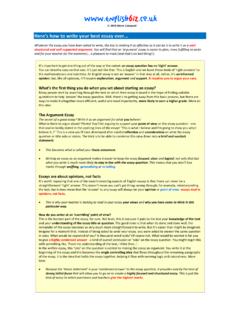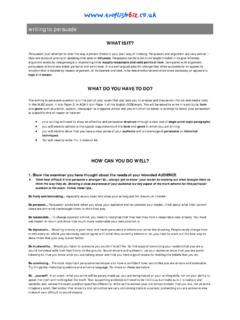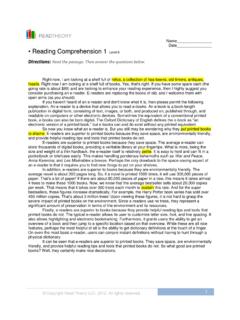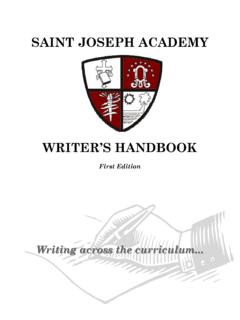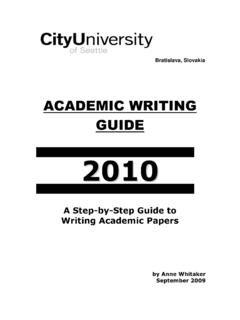Transcription of Essay Writing Guide — - Steve Campsall
1 2014 Steve Campsall Essay Writing Guide WHAT IS AN Essay ? An Essay can never give answers it can only offer views ; and these need to be argued for. You need to argue in support of a view that becomes your answer to the Essay or exam question. This is something that you propose, assert or conclude about a text you have read. What you assert and you do this in the opening lines of the Essay is your considered overall response. This is what you have concluded as an answer to the Essay question by weighing up the evidence provided by the text itself. It goes without saying that you won t be able to come to any worthwhile conclusion without knowing the text well. This is because you need to weigh up the evidence it provides to help answer the exam question. As you read through the text (or think through it in an exam), look for / think of quotations that will slowly allow an overall view to form in your mind.
2 Make notes of these quotations the line or page numbers, for example. Make notes, too, of the overall as it is forming in your mind. For coursework, a good system is to use Post-it notes stuck to the pages where the quotations are, each with a small note of what evidence you have found to support your view. o If the text is a play where you feel some of the evidence isn t dialogue, but is to do with direction, props, lighting or sound, for example, or you feel that good evidence can be found from the structure of the story, you won t need quotations; instead, you ll need an explanation and description of what the audience see on stage or of the effects on the reader / audience created by the sequencing of dialogue or action ( structure). Beginning the Essay Effectively Your Essay should begin with a clear, meaningful and confident-sounding statement. This is the assertion that summarises succinctly your overall answer to the Essay or exam question.
3 You can add to this with a brief comment of the context from which the idea for the story, poem or play arose. This will be the background social or political situation that forms the themes of the text. Finally, in the opening paragraph, in order to set up the structure of the Essay , you ll need the list of evidence you made as you were reading or thinking through the text. If you have been able to come to an overall view as an answer to the exam question, then this view will have formed in your mind because of certain features or aspects of the text. It is this that forms the evidence you will build the remaining paragraphs around. In the opening paragraph, it can really help to write this down in a super-summarised, almost list-like form that gives the main reasons you came to the point you ve just stated. It will be made up of the main literary and linguistic (or dramatic, depending on text) aspects of the text that brought you to your stated viewpoint.
4 Working out a summary of your view can be difficult, Practising on several past questions can help you won t need to write the whole Essay for this practice as you are just trying to condense your view into a kind of overview a statement or assertion that without any evidence being offered states your answer . What follows is some help with how to develop an overall answer suitable for the opening paragraph. Coming Up with an Assertion Think of Your Essay Like This In your imagination, be back in class. Imagine your teacher asks you the Essay question. What is expected in reply? A thousand-words? No it s home-time in five minutes after all! What s needed is a super-condensed-in-a-nutshell- view . And this is what your written Essay needs to open with. In a way, this is your take on the Essay question. It might begin with, As I see it, these two writers present the theme of love in various ways some similar, some very different.
5 Shakespeare, for example explores romantic love through the characters whereas the poet, John Donne . This statement forms your assertion with which to begin your Essay . Of course, there s no evidence or explanations here, just a statement of what will become the Essay s controlling idea that will be explained and supported throughout the Essay . Need More Detail? It s Writing the Essay In the first paragraph, you need to start, in a way, with your conclusion . This isn t the same as the Essay s conclusion exactly but it s not so very different. This seems so how can this be? The opening paragraph is where you state what you have concluded concerning the Essay question. This means explaining what you have understood the Essay question to be asking and giving your response to it as a super-condensed-in-a-nutshell-view . Remember, this must be no more than a very brief overview answer (which is, in a way a conclusion , isn t it?)
6 But technically it s called your thesis statement ). What s needed is a confident-sounding statement that gives your overall take , answer , view , conclusion (call it what you will!) of the text focused on the Essay title or question. The reason this is so necessary to put in the opening paragraph is because it sets up your Essay s argument perfectly. To be able to create such a statement, you ll need to have a sound knowledge of the text(s). So, if you don t yet know your texts well enough to give a sensible and well-developed view, then (if this is for coursework or a controlled assessment ), re-read the text(s) and, if needed, read a study Guide , too. GET TO KNOW YOUR TEXTS! You ll also need to work through your text(s) to note down a series of quotations or examples that you ll be using to support the various points you will develop in the body paragraphs of the Essay . This is because you need to show that your views arise from and are firmly rooted in your interpretation of the text(s) itself.
7 Maybe use different coloured Post-It notes to keep tabs on these quotations and write on each note a very brief explanation that will help when you use the quotation in your Essay . There s a little more needed in the opening paragraph. Add in a little more detail about what aspects or parts of the text brought you to your stated conclusion and show how you will use these to help support your answer . For example, you might write, depending on the Essay title, I formed this interpretation from the ways the author creates the characters of X, Y and Z; by analysing each of these in turn, I hope to The idea here is to give the general direction that your Essay will take and show how your argument will progress. If carefully done, this will provide you with a series of signposts that will Guide the structure of your Essay . Now, in your you re back in class! What might follow on from the super-condensed-in-a-nutshell-view you gave to your teacher?
8 Well, your teacher might add: Good, that s a fair view to hold; but tell me why your interpretation leads you to think that. Show me how some aspects of the text brought you such insights and to that interpretation. In the written version of the Essay , you ll need to provide a good deal of this kind of evidence . Most often this will be in the form of quotations, with each one accompanied by an introductory point that links to the Essay s argument or thesis. The quotation should be followed by a substantial explanation in which you work through important detail concerning, for example, the methods the writer used, the effects the quotation creates in a reader s mind and the likely purposes. This will often require a two-fold explanation. Why? There will be a local purpose, that is, what the quotation is doing at the point it occurs structurally within the text. This will likely be to help develop a tense plot, or to add atmosphere, develop a character, and so on.
9 There will also be a second purpose. This is because all literature is written in a coherent and unified way, with everything in the text leading to an overall idea or set of ideas behind the text . These are the themes of the text ideas that arose in the writer s mind as their response to the situation in which they lived, that is, their context. This will be a moral, political or philosophical viewpoint, one they wish to persuade the reader to come to accept. Looked at like this, literary texts are examples of persuasive Writing . You ll also need to add a comment on the effective literary and linguistic merits of the quotation. To do this effectively, you ll need to use what is called the P>E>E technique. The P>E>E Technique This technique MUST form the basis for each body paragraph of your Essay . Body paragraphs are the explanatory paragraphs that lie between the opening and concluding paragraphs of the Essay . They explain and support the assertion given at the beginning.
10 Each body paragraph should open with a Point. This point will add support for the super-condensed-in-a-nutshell assertion you made at the beginning. You need to be clearly and obviously developing the Essay s overall argument as the body paragraphs progress. This means using a range of quotations or, to gain marks for structure (you have to cover form, structure and language ), you give an explanation rather than a quotation. Following this opening point, you now need to explain it better and show how and why you think it supports your overall view. Usually, this means giving an Example from the text (most often as a brief quotation, but in a play it could be a description of the stage action, or of how dramatic irony is working on the audience, for example. Make certain that the quotation is as short as it can be but equally, make sure it does clearly help you make your point). Following the quotation, certain things now need exploring to complete the PEE structure and gain those high marks you deserve.

